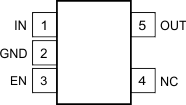SBVS195F September 2012 – August 2019 TLV713
PRODUCTION DATA.
- 1 Features
- 2 Applications
- 3 Description
- 4 Revision History
- 5 Pin Configurations and Functions
- 6 Specifications
- 7 Detailed Description
- 8 Application and Implementation
- 9 Power Supply Recommendations
- 10Layout
- 11Device and Documentation Support
- 12Mechanical, Packaging, and Orderable Information
Package Options
Mechanical Data (Package|Pins)
Thermal pad, mechanical data (Package|Pins)
- DQN|4
Orderable Information
5 Pin Configurations and Functions
DBV Package
5-Pin SOT-23
Top View

Pin Functions
| PIN | I/O | DESCRIPTION | ||
|---|---|---|---|---|
| NAME | NO. | |||
| X2SON | SOT-23 | |||
| EN | 3 | 3 | I | Enable pin. Driving EN over 0.9 V turns on the regulator.
Driving EN below 0.4 V puts the regulator into shutdown mode. |
| GND | 2 | 2 | — | Ground pin |
| IN | 4 | 1 | I | Input pin. A small capacitor is recommended from this pin to ground. See the Input and Output Capacitor Considerations section in the Feature Description for more details. |
| NC | — | 4 | — | No internal connection |
| OUT | 1 | 5 | O | Regulated output voltage pin. For best transient response, a small 1-μF ceramic capacitor is recommended from this pin to ground. See the Input and Output Capacitor Considerations section in the Feature Description for more details. |
| Thermal pad | — | — | The thermal pad is electrically connected to the GND node. Connect to the GND plane for improved thermal performance. | |
